-
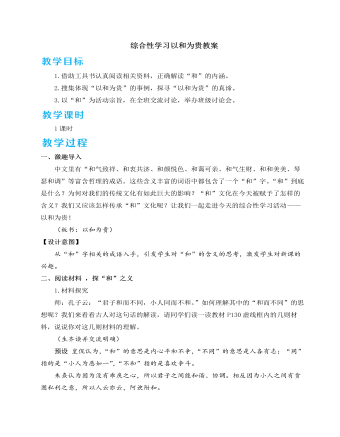
人教部编版语文八年级下册综合性学习以和为贵教案
请同学们阅读教材P133虚线框内的内容,根据要求选择某一新闻事件,开展时事讨论,积极发表看法。提示:学生围绕事件展开讨论,积极发言,认真听取同学的意见,讨论时注意遵守之前制定的“班级议事规则”。(全班讨论,师总结)【设计意图】此环节通过开展班级讨论活动,制定贴近学生生活的“班级议事规则”,将学习的与“和”相关的知识引入实践生活,培养学生运用知识指导生活实践的综合能力。五、以“和”为文,总结收获师:同学们,通过本次综合性学习活动,我们知道了“以和为贵”不仅是为人处世的准绳,也是从政治国的法宝,是处理国际关系的原则,是创建和谐社会的前提条件。通过这次活动,你对中国文化中的“和”一定也有了许多的认识和理解吧!任选一个角度,写一篇不少于600字的作文,谈谈你的收获。
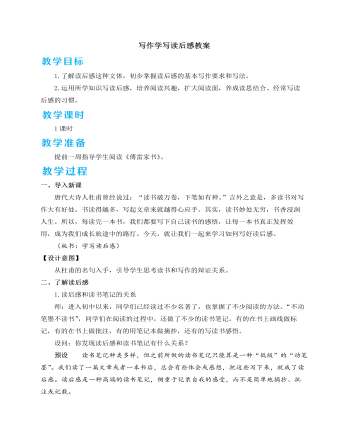
人教部编版语文八年级下册写作学写读后感教案
师小结:本篇习作开篇概述原作内容,抓住要点,简明扼要。感想的内容,先扣住深沉的父爱,表达自己对傅雷的敬意,然后赞美现实生活中父爱的伟大。思路清晰,情感真挚。【设计意图】以《傅雷家书》读后感写作为例,指导学生如何写读后感。重点指导“点引议联结”的基本结构,让学生写作有章可循。四、尝试写读后感1.写作内容师:同学们已经阅读了《傅雷家书》,请大家回顾内容,自拟题目,按照今天讲的写读后感的方法,先列出写作提纲,再写成作文,不少于600字。2.能力提升用已学的读后感知识,修改自己的作文。并反思所写读后感是否有以下不足:(1)以“引”代“感”。读后感,顾名思义,主要是写“感”,引述是为写“感”服务的,但有些同学往往忘记了这一条,本末倒置,大量抄录或复述原文,结果犯了以“引”代“感”、代“联”的毛病。
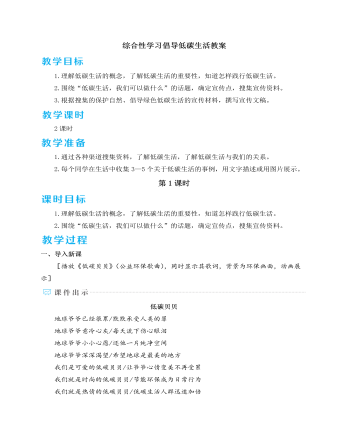
人教部编版语文八年级下册综合性学习倡导低碳生活教案
一是缩小页边距和行间距,缩小字号。正式文件一般对字号、间距有严格的要求,但是在非正式文件里,可适当缩小页边距和行间距,缩小字号。可“上顶天,下连地,两边够齐”,对于字号,以看清为宜。二是纸张双面打印、复印。纸张双面打印、复印既可以减少费用,又可以节能减排。如果全国10%的打印、复印做到这一点,那么每年可减少耗纸约5.1万吨,节能6.4万吨标准煤,相应减排二氧化碳16.4万吨。三是打印时能不加粗、不用黑体的就尽量不用,能节省墨粉或铅粉。此外,能够用电脑网络传递的文件就尽量在网络上传递,比如电子邮件、单位内部网络等,这样下来也可以节约不少纸张。(选自《低碳校园——让我们的学校更美好》,天津人民出版社2013年版)(学生围绕各自任务,课外搜集制作宣传材料,时间为一周。)【设计意图】本环节先从探讨自身在低碳生活中力所能及的事情,让学生切实认识到低碳生活就在日常的一举一动中。然后围绕主题分组,并保证足够的时间,让学生去收集整理资料,落实任务,使学生能真正成为低碳的倡导者和践行者。
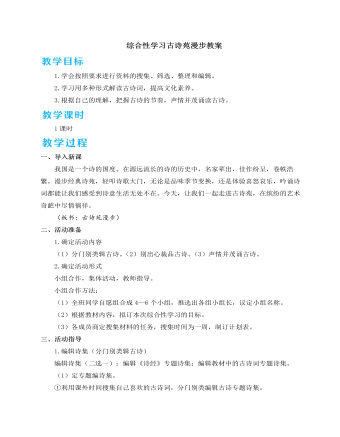
人教部编版语文八年级下册综合性学习古诗苑漫步教案
解说词:画卷上的竹子,在石缝中挺然而立,坚韧不拔,遇风不倒。郑板桥先生借竹抒发了自己的洒脱与豁达,表现了他勇敢面对现实、绝不屈服于挫折的品性,令竹子人格化了。此时,“诗是无形画,画是有形诗”。4.声情并茂诵古诗(播放相关的主题图片和音乐,尽量让诗歌和音乐、画面相融合)主持人:诗除了追求意境的图画美之外,还特别注重节奏和韵律,具有音乐美。我们理解了诗中的情愫后,便可以通过朗读来诠释这种种情愫,或低声絮语,或慷慨悲吟,或温情述说……请大家选择自己最喜欢的一首诗词或一小节诗歌,用你认为最贴切的情感和方式朗读,并说出这样处理的原因,或讲述你与此诗有关的故事。朗读示例:无言/独上西楼,月/如钩,寂寞梧桐/深院/锁/清秋。剪不断,理还乱,是离愁,别是/一般滋味/在心头。解说词:此词是南唐后主李煜被囚于宋时所作,表达了他离乡去国的锥心之痛。朗读时要表现出那种深切的故国之思、亡国之恨。
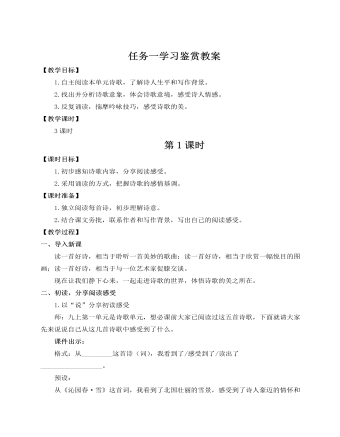
人教部编版语文九年级上册任务一学习鉴赏教案
审美鉴赏与创造——诗歌意象“诗是无声画”,诗要用形象说话。一般说来,诗歌写作是由“灵感—寻象—寻言”这三个阶段构成的。获得灵感,就是获得一种诗美体验;获得诗美体验之后,就要将诗美体验转化为诗歌意象。诗歌意象创作要注意以下几个方面:1.象征手法的运用。象征多用具体生动的形象来暗示某种生活、情绪和哲理,可以将抽象的事物变得具体可感。2.要善于将抽象的感情形象化。诗歌创作中,或是即事抒情,或是融情于景,或是托物言志,要尽力将情感形象化,避免单纯地抒情。3.意象的组合。意象组合是用一个接一个的意象,按照一定的美学原则把它组合起来,形成一幅幅跳跃的画面,使它们产生对比、衬托、联想、暗示等作用,让读者通过一系列的意象组合去揣摩和领悟作者的意图。
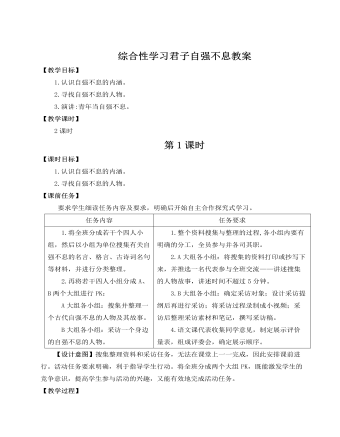
人教部编版语文九年级上册综合性学习君子自强不息教案
正如朱敏先生所说的那样,他之所以能打败那些强大的对手是因为自己的一股韧劲。自强的心鞭策我们勇往直前,失败算什么,困难算什么,自强者永不止步。生命可以大写,也可以小写,还可以简写。小写的生命是灵魂上的侏儒,简写的生命是灵魂上的庸碌者,唯有自强者是天地间用正气、智慧写出的一个气宇轩昂的大写的人。独立是它的一撇,拼搏是它的一捺,两者缺少其一,都不能称之为一个完整意义上的“人”。自强是生命之杯中的琼浆玉液,他让每一个举杯者赢得了鲜花和掌声,收获了成功和喜悦,体味到了人生的真实与厚重!在我们的人生旅程中,每个人或多或少会遇到这样那样的挫折。也许是一次考试的失利,也许是一场突如其来的意外,没有谁能够保证他的一生总是平平安安、一帆风顺。面对挫折我们不应该失意、彷徨,因自己陷入人生灰色的圈子而倍感焦虑、难以自拔。我们要学会自强,因为只有学会自强,我们才敢正视所有问题;只有学会自强,才会有勇气去战胜一道道难题。
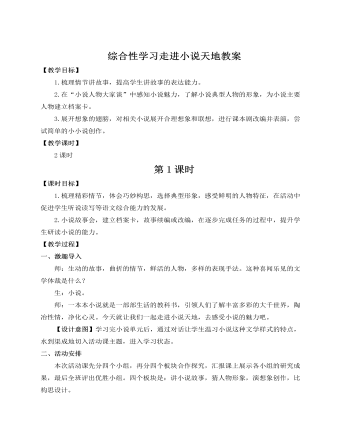
人教部编版语文九年级上册综合性学习走进小说天地教案
课件出示:(1)我的小报设计构想:古典名著是我最喜欢的读本,除了老师规定的板块设计外,我增加了“人物形象我评说”的新板块,我画了人物简笔画,画面配上了简洁的评语……(2)我的小小说《找钱》:我先读一读我的小说,再说一说我创作小说的经验。……丢钱是我们生活中常有的事情,材料就选自我们身边。找钱的过程最好安排得一波三折,情节要有波澜,我把两个身边同学丢钱找钱的事情融合在一起,通过三次满怀希望的寻找和三次失望的转折,使得小说情节引人入胜。小说中大量的人物心理描写,凸显了人物性格——疑神疑鬼,没心没肺。最后小说的结尾出人意料,却又在情理之中……【设计意图】综合性学习的汇报课,检查学生自主探究学习的成果。四小组分四个不同的板块分别汇报,内容清晰,任务明确。有个人汇报评价得分,也有小组综合评价得分,评出优胜者和优胜小组。通过竞争激发课堂活力,通过合作增强集体荣誉感,通过展示刺激表现欲,让学生成为真正的课堂主人。
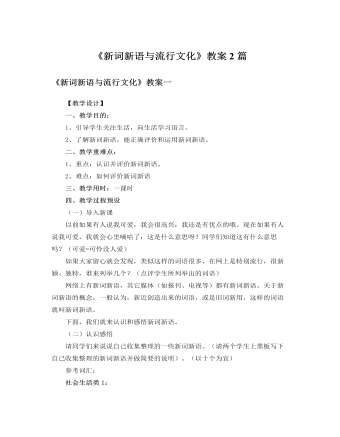
人教版高中语文必修1《新词新语与流行文化》教案2篇
【教学设计】一、教学目的:1、引导学生关注生活,向生活学习语言。2、了解新词新语,能正确评价和运用新词新语。二、教学重难点:1、重点:认识并评价新词新语。2、难点:如何评价新词新语三、教学用时:一课时四、教学过程预设(一)导入新课以前如果有人说我可爱,我会很高兴:我还是有优点的哦。现在如果有人说我可爱,我就会心里嘀咕了:这是什么意思呀?同学们知道这有什么意思吗?(可爱=可怜没人爱)如果大家留心就会发现,类似这样的词语很多,在网上是特别流行,很新颖、独特,谁来列举几个?(点评学生所列举出的词语)网络上有新词新语,其它媒体(如报刊、电视等)都有新词新语。关于新词新语的概念,一般认为,新近创造出来的词语,或是旧词新用,这样的词语就叫新词新语。
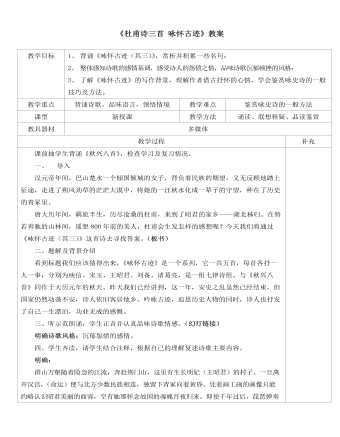
人教版高中语文必修3《杜甫诗三首 咏怀古迹》教案
“千载琵琶作胡语,分明怨恨曲中论。”“怨恨”两字点明全篇主旨。千百年来,琵琶所演奏的总是从匈奴传来的撩人愁思的胡乐,正是昭君在诉说着她的怨恨!这两句从侧面烘托昭君的形象,既有对她的赞扬,又有对她的同情。读到这里,我们的耳边好像又响起了那深沉、幽怨的琵琶声!5、这首诗写的是昭君的怨恨,但首联一开始并没有写她的怨恨,写的是什么?这样写的目的又是什么?明确:群山万壑赴荆门山是群山起伏,连绵不绝;水是万壑争流,奔腾不息,直赴荆门山。其中的“赴”字用了拟人的手法,把迤逦不绝的千山万壑陡然间写活了,既有飞动之势,又有变幻之姿。从侧面烘托昭君的形象。两千多年前,一个青年女子远离父母之邦,嫁到异域,并在那里度过一生,确实需要巨大的勇气和毅力,而这雄伟的山川简直就是她那坚强的性格的象征。6、佳句鉴赏(这首诗歌当中,我认为有两句诗写得非常美,我自己很喜欢,不知道有没有同道中人?)

人教版新目标初中英语七年级上册Can you play the guitar教案
本单元主要是学习情态动词can的肯定句、否定句、一般疑问句,肯定与否定回答,以及特殊疑问句的构成和用法;复习what弓!导的特殊疑问句。本单元主要围绕“加人俱乐部,谈论自己的能力”这一话题,设计了三个任务型活动:任务一是:自己的才艺表演,学习情态动词can的用法;任务二是:自己建立俱乐部,运用情态动词can谈论自己在某一方面的能力、喜好和意愿;任务三是:我能成功,主要是复习巩固谈论各自的爱好和特长的方法。单元知识系统(树)Can you/he/she/you dance? 一Yes,I/he/she/we can./No,I/he/she/we can’t.Can Bill play the guitar?一Yes,he can,but he can’t sing.单元总体目标通过学习情态动词can的用法,使学生能够表达自己在某一方面所具备的才能;能够谈论自己的喜好与意愿;能够为自己成立的各种俱乐部制作海报;会写招聘广告。单元重难点一览重点 难点I.复习词汇:can,play,want2.词汇:guitar, dance, swim,sing, chess, speak, drum,trumpet,violin,play the guitar3.句型:Can you/he/she/you dance?Yes,I/he/she/we can./No,I/he/she/we can’t.Can Bill play the guitar?

人教版新目标初中英语八年级上册How was your school trip教案2篇
“Go for it!” is based on “Task-Based Language Teaching”. It adheres to “The authenticity principle”, “The form-function principle”, “The task dependency principle” and “The principle of learning by doing”. These principles all accord with the demands of curriculum focus.In and of Grade Seven (II), “Go for it!”, students have learned “The Simple Past Tense”. And it appears again in of Grade Eight (I). teaches students more about how to talk about events in the past. In addition, it gives affirmative and negative statements in the past tense, such as the sentence patterns “Did you see …?” “Were there …?” “Did you go …?” As the first part of Unit 8, Section A opens with a picture presenting the last school trip in the aquarium and continues with several step-by-step practice activities, which are all good for students to master “The Simple Past Tense”. Doing well in Section A will help students integrate the new target language with that in Section B. Thus, they can describe the events in the past freely and foster their own ability of reflecting and practicing. II. Teaching ObjectivesTeaching objective is the beginning and aim of teaching activities. According to the overall goal of the English elementary course--- improve students' synthetic ability of language application, which should be based on the development of students’ “Language knowledge”, “Language skills”, “Character building”, “Learning strategies” and “Cross-cultural awareness”. The teaching objectives are described as follows(I). Knowledge objectivesi. Master the simple past tense of regular and irregular verbsii. Recite the new words and expressions about the last school trip in the aquarium, including their pronunciation and intonation

人教版新目标初中英语八年级上册What are you doing for vacation教案2篇
Teaching goals : 1. Words & phrases: babysit ,get back , fishing , rent , think about , decide(on) , tourist etc. 2. How to talk about future plans . 3. 现在进行时表示将来计划或行动. 4. 特殊疑问句(where , when , how long引导) Important and difficult points : Drills :What are you doing for vacation ? I’m watching TV . When are you going ? I’m going … . How long are you staying ? We’re staying for five days . Teaching aids : cards and a tape ,a large wall calendar . Period 1 Teaching procedures : Step 1Leading in1. Free talk . 2. Put up the wall calendar . T: I’m staying home on Saturday (pointing to next Saturday ).Ss repeat . Ss: I’m staying home on Saturday . T: OK. Today we’ll learn how to talk about future plans. Step 2Pre-task SB Page 13 , 1a . 1. Look at the picture carefully and tell what you see in the picture . 2. Write the activities from the pictures in the box and add some more . 3. Practice reading . Step 3While-task1. Using the activities we write in 1a to make conversations .For example :What are you doing for vacation ? I’m visiting my uncle . 2. Pairwork .Practice in pairs . 3. 用第三人称练习对话.

人教版新目标初中英语八年级下册What should I do教案2篇
说明:在帮Li Lei提建议的同时,教育学生如何学好英语。第三课时教学目标1. 语言目标:a) 词汇: Original, in style, haircut, the same as.b) 语言结构:My friend wears the same clothes and has the same haircut as I do.2. 能力目标:大多数学生能够谈论自己喜欢哪种服装,提高查找信息的能力。3. 情感目标:学会如何与朋友相处,要有自己对时尚的看法。教学重点掌握一些重要词汇。教学难点学会谈论问题,并能提出书面建议。◆教学突破首先针对Erin的问题,提出个人的建议,模仿2c部分的对话展开双人交际Pair-work;听老师诵读3a部分的信件,并找出LEFT OUT的问题所在;学生完成3b部分的内容,给Left Out提出书面的建议;学以口头形式提出自己目前存在的某个问题,讲给大家听,让同学们给自己提出一个建议,并作笔录;学生两、三个人分成一组,随意性地进行口语交际,谈论P14的第4部分的某个问题,相互交换意见。

人教版新目标初中英语八年级上册What’s the matter教案2篇
She shouldn’t go to the party tonight.Step7. TaskT: You know, there are lots of problems in our life. If you are a doctor, please tell us how to solve the problem. I will divide you into 9 groups. Please work in groups. And then choose one of you to report your ideas.The following are the problems:I have a toothache.I am hungry. I have a sore throat.I am stressed out. I have a sore back.I am tired. I can’t sleep.I have a cold. I have a headache.Report: If you have a headache, you should go to bed early. You should see the doctor. You should eat some medicine. You shouldn’t wash your face with cold water.You shouldn’t sleep late.You shouldn’t swim.…..T encourages the students to give advice as much as possible.Homework:1. Chose one of the problems, and write down your advice2. Copy the new words这一步是用于热身的,同时也可以让他们复习一部分的表示人体部位的单词,扩充知识.学习语言的过程也是一个不断积累的过程,复习旧知识,增添新知识.通过小游戏,强化学生对Does she/he have…这个句子的运用能力.通过复习,自然的引到下面新知识的学习。充分利用表格,由句子到对话,再到文章,让学生循序渐进. 提高学生的综合语言运用能力,运用以前学过的知识来解决身边的问题.Period 5 (Section B 3a—3c, selfcheck)教学内容与分析:

人教版新目标初中英语八年级下册If you go to the party, you’ll have a great time教案2篇
区分宾语从句、定于从句和状语从句宾语从句和状语从句,都叫做主从复合句。宾语从句主要是中考必考的,是初中阶段必掌握的从句,宾语从句主要是掌握三要素,所谓宾语从句,就是宾语在主从复合句当中充当宾语的一个句子,叫做宾语从句。主句的谓语动词是及物动词,后面如果是词或者是短语的话,是简单句,如果是句子的话,肯定是宾语从句。I know that he good at English.就是宾语从句,三要素,一要素是要注意连词,连词一共学了三类连词,一类连词是that口语当中可以省略,就像刚才说的那一句,I hear he is good at English.还有疑问代词、疑问副词,how where when,疑问代词、疑问副词。还有一类连词weather是否的意思,不是状语从句当中的如果,这一定要和如果区分开,这是是否。I don't know if he interested at English。宾语从句要注意if是连词。第二要素是语序,要用陈述举语序。比如说你家有几口人,我们都说How many people are there in you family?但是这是简单句,一旦说成宾语从句,你可以告诉我你家有几口人吗?Could you tell me how many people there are in you family ?

人教版新目标初中英语八年级下册How long have you been collecting shells教案2篇
Step Ⅱ Show the new words on the screen and teach the new words. Read the new words to students and ask them to repeat.Step Ⅲ 3aThis activity introduces new vocabulary and provides reading practice using the target language.In this activity first look at the four pictures.T: What can you see in the pictures?Ss: Four snow globes.T: Right. There are four snow globes in the pictures. And what are they?Ss: They are a monster, two polar bears, two penguins and a birthday cake.Write these words on the blackboard: snow globe; monster; polar bear; penguin and birthday cake. Read them to the class and ask students to repeat each one. Make sure students understand each word.Use a computer to show the E-mail message on the screen and read the message to students.Get students to read the e-mail on their own, and then draw lines connecting each snow globe and its description.Correct the answers.AnswersA line should connect each snow globe picture with the words that describe it in the letter.Step Ⅳ 3bThis activity provides writing practice using the target language.First review Activity 2a on Page 47.Then ask students to complete the message according to Activity 2a.Some partial sentences are given to students. Write about one person's collection.When students work, walk around the room checking the progress and offering help as needed.When they finish, ask some students to read their messages to the class.

人教版新目标初中英语九年级上册Teenagers should be allowed to choose their own clothes教案2篇
Step 1 Greeting Greet the class and check the homeworkStep 2 A duty report The S on duty gives a report on the rules in his home and lead in 3a “Sun Fei’s and Wu Yu’s rules” Step 3 ReadingSs read the conversation and write the two girls’ rules in the chart. Check the answers.Get Ss to read after the tape and then read aloud by themselves. Then, T explains the language points.Step 4 Pairwork 3bRole play. Use the information in chart to practice with the conversation in 3a covered. They can look at the sample conversation in the right box.Step 5 Task 2 “Who’s the best reporter?”Make a survey by asking any 5 students the questions in the chart in activity 4. Then give out a report about it. See who is the best reporter? And the best reporter will get a nice ball-pen.Step 6 Summary and homework:Write out the report in your exercise-books.Period ThreeStep 1 Greeting and a duty reportThe S gives a duty report talking about his experience of being late for school. Lead in the question “Do you ever get to school late? How often do you get to school late? Always, usually, sometimes, or never?Step 2 1a Get Ss to finish writing.Step 3 Pairwork 1b Get Ss to talk about their answers with their partners using the sample conversation in the box on the right.Step 4 Listening practice2a Lead-in: What will happen if you get to school late? What about Peter? Let’s listen to a conversation between Peter and his father. Get Ss to finish 2a (As usual, for the first time, Ss only listen.) Check the answers.

人教版新目标初中英语九年级上册I used to be afraid of the dark教案
内容提示1.本单元主要内容是学会used to结构。Used to +动词原形表示过去经常、以前常常,只用于过去式中,用来表示现在已不存在的习惯或状态。例如:They used to play football together.他们过去常在一起蹋足球。(现在不在一起踢了)2.used to的疑问形式和否定形式为Did you use to…?和I didn’t use to… 也可以用Used you to…?和I used not to…但现在多使用前者。例如:Did you used to swim in the river? 你过去常在河里游泳吗?I didn’t use to play the piano. 我以前并不经常弹钢琴。教学目标一、学习目标(Language Goal) 1.学会陈述自己过去常做的事情。2.学会陈述自己过去的爱好等。3.能够表达自己现在和过去在外表、性格、娱乐等方面的变化。4.能够表达朋友、家人等现在和过去的变化。二、语言结构(Language Structures) 1.I used to be short when I was young. 我年轻时个子很矮。 2. —Did you use to have straight hair? 你过去是直发吗?—Yes, I did. 是的。 3. —Did you use to play the piano? 你过去弹钢琴吗?—No, I didn’t. 不,我不弹。 4.I used to be afraid of dark. 我过去害怕黑暗。 5.I’m terrified of the snakes. 我害怕蛇。

人教版新目标初中英语九年级下册By the time I got outside, the bus had already left教案
Ⅰ. Teaching Aims and Demands1. Knowledge Objects(1) Key Vocabularyoversleep(2) Target LanguageWhat happened?I overslept. And by the time I got up, my brother had already gotten in the shower.2. Ability Objects(1) Teach the students to use the new words.(2) Train the students to narrate past events with the Past Perfect Tense.(3) Train the students' listening and speaking skills with the target language.3. Moral ObjectIt’s a good habit to go to bed early in the evening and get up early in the morning. So you’ll never be in a hurry in the morning.Ⅱ. Teaching Key Points1. Key Vocabularyoversleep2. Target LanguageNarrate past events with the Past Perfect TenseⅢ. Teaching Difficult Points1. Train the students to narrate past events with the Past Perfect Tense.2. Train the students to understand the target language in spoken conversation.Ⅳ. Teaching Methods1. Thinking of examples from the students' real lives.2. Making sentences by looking at the pictures.Ⅴ. Teaching AidA tape recorderⅥ. Teaching ProceduresStep I Revision1. Revise the language points in Unit 8.Ask some questions like this: What volunteer work would you like to do?Help the students to answer, I’d like to…/I love to…/I hope to2. Practice the dialogue in Activity 3c on page 62 again. Get students to role play the similar dialogues with the following.

人教版新目标初中英语九年级下册I’ll help clean up the city parks教案
Talk about offering help (P60)I’ll help clean up the city parks.A: I’d like to work ...B: You could help ...Talk about ways to tell people about the Clean-Up Day (P61)We need to ...We can’t ...I’ll ...Talk about the work the volunteers do (P62)These three students all volunteer their time to help other people.Somebody loves to ... / helps ... / plans to ... / wants to ...A: What do you like doing?B: I like ... A: What kind of volunteer work do you think I could do?B: You could ...1. 重点词汇advertisement, fix, repair, pleasure, blind, deaf, shut, carry, specially, fetch2. 认读词汇hunger, homeless, cheer, clean-up, sign, establish, major, commitment, elementary, veterinarian, coach, similar, call-in, strategy, disabled, organization, unable, support, appreciate, donation, part of speech, pronoun, adverb, preposition, conjunction, donate, Jimmy, Sally3. 词组clean up, cheer up, give out, put off, set up, think up, take after, fix up, give away, put up, hand out, work out, at once






